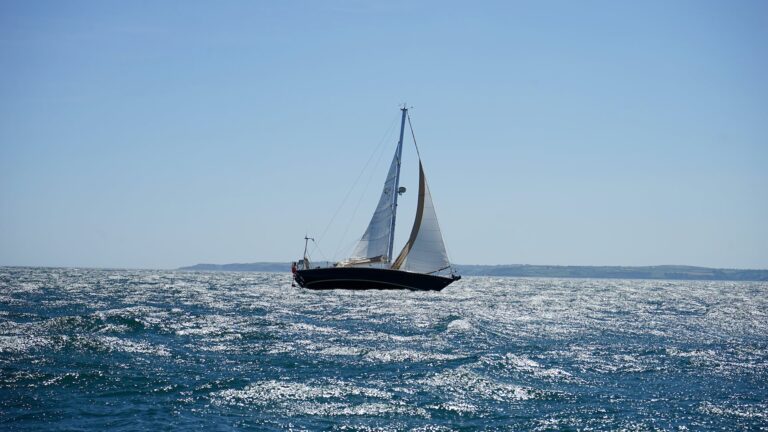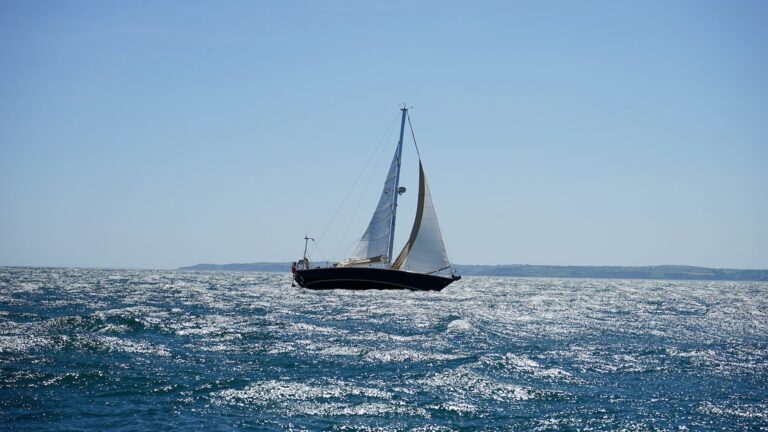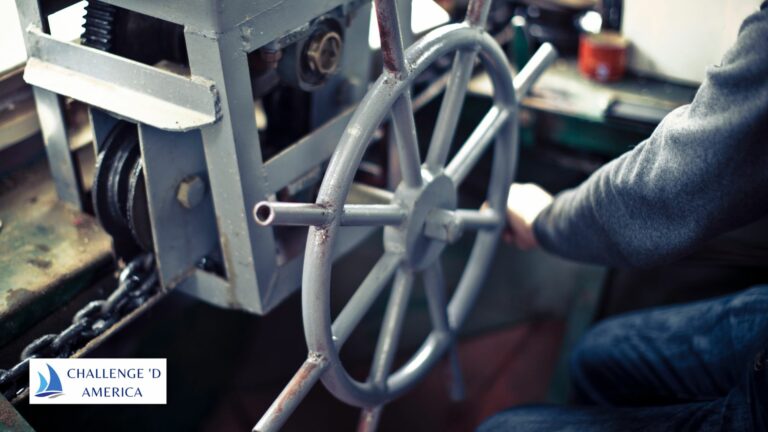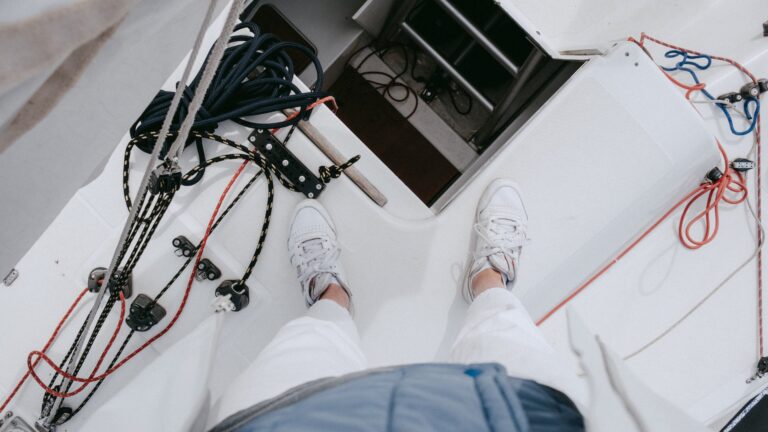What Are Lazy Jack’s On a Sailboat?
Sailing is an amazing experience that anyone can enjoy, but it’s important to understand the basics of sailboat maintenance and rigging before taking to the open seas.
One essential part of sailboat rigging is the lazy jack system, which helps keep your mainsail in place when it’s lowered or reefed and ensures that you don’t have to worry about it flapping around in the wind or getting tangled up in the lines.
In this article, we’ll explore what lazy jacks are, how to set them up, and some best practices for sailboat maintenance and sailing with lazy jacks on board!
What Are Lazy Jacks?
Lazy jacks are networks of lines that are rigged along each side of the mainsail from multiple points on the boom or a stack pack to a point on the mast just above the spreaders, at about 60% the mast’s height.
Their purpose is to hold the mainsail on top of the boom when it is lowered. This eliminates having to manually fold up the sail or having it flap around in gusty winds while you’re trying to secure it in place, making sailing easier and safer overall!
Benefits Of Using Lazy Jacks
Having lazy jacks installed on your boat can make sailing much more enjoyable and safe by eliminating some of the most frustrating parts of lowering or reefing sails in high winds or choppy seas.
Additionally, they help reduce wear and tear on your sails by keeping them secure when not in use, and they can even be used as additional support for your mainsail when you’re running close-hauled in strong winds!
Types Of Lazy Jacks
There are two main types of lazy jacks: standard lazy jacks and stack packs (or “Dutchman” systems). Standard lazy jacks consist simply of lines running from points on the boom down to points on the mast, these allow you to easily control how low you want your mainsail lowered without having to pull down too hard on one line or another – this makes sail lowering quicker and easier overall!
Stack packs (or Dutchman systems) are slightly more complex, they involve multiple lines running all along each side of your mainsail which can be deployed as needed – this allows you to have full control over where you want your mainsail when reefing or lowering!
How To Rig a Lazy Jack System
Rigging a lazy jack system is relatively simple, however, there are some important steps that must be followed carefully in order to ensure that your system is properly setup and functioning correctly! The first step is deciding which type of lazy jack system you’d like – standard or stack pack – and then selecting all necessary components for your chosen system (including lines, cleats, etc.).
After everything has been selected, it’s time to begin rigging – start by attaching one end of each line at points along each side of your boom (at least two per side), then run those lines up through blocks at points around 60% up your mast (or higher if preferred), before finally attaching them securely near their destination point with cleats or other suitable fasteners!
Make sure all lines are taut but not overly tight throughout this process, if any lines become too loose they may sag down towards the deck during use, creating potential hazards onboard!
Best Practices For Sailboat Maintenance
When using lazy jacks there are some best practices that should be followed in order to ensure maximum safety while sailing: always make sure all lines are taut but not overly tight, check all connections regularly for signs of wear or damage, never leave a boat unattended with sails still rigged, ensure boom vang tension is adjusted correctly before raising or lowering sails, keep an eye out for any buildup of dirt/debris along sail tracks/sliders that could cause sticking/binding during use, make sure all cleats/fasteners used throughout rigging process are securely attached so they don’t come loose during use, inspect all rigging regularly for signs of wear/damage/corrosion – replace any parts as needed! Lastly, always remember that having good working knowledge about sailing will go a long way towards making every voyage safe and enjoyable!
Tips For Setting Up And Using Lazy Jacks
When setting up a new lazy jack system there are a few tips worth following: always make sure all lines run parallel with each other rather than crossing over one another – this will help prevent tangling during use, use blocks wherever possible rather than tying off directly onto hard points such as cleats – this will reduce friction while raising/lowering sails, make sure all connections made between components are secure so they don’t come undone during use, inspect all components regularly for signs of wear/damage/corrosion – replace any parts as needed.
Additionally, when using lazy jacks always remember that raising/lowering sails should be done slowly – avoid sudden pulls which could cause damage/tangling within rigging system!
Conclusion
Lazy jacks can be an invaluable addition to any sailboat setup, providing an easy way to keep sails securely held onto booms while also reducing wear & tear from manual folding & handling. With proper setup & maintenance these systems can provide many years’ worth of hassle-free sailing experiences!
All sailors should take some time to familiarize themselves with how these systems work & what best practices should be followed when using them onboard their boat – following these tips will help ensure every voyage is safe & enjoyable!
Additional Resources
If you’d like more information about setting up & using lazy jack systems onboard sailboats there are plenty great resources available online: Sailing Magazine has some excellent articles covering everything from basic setup instructions right through advanced tips & tricks – well worth checking out if you’re looking for more info about how these systems work & how best to utilize them onboard your boat!
Additionally Boating Magazine has several useful resources covering topics such as choosing types & components for different setups plus general advice about proper maintenance & upkeep – definitely worth checking out if you’re looking for more info about how these systems work & how best to utilize them onboard your boat!
FAQ
What type of line should I use for my lazy jack system?
The type of line used depends largely on personal preference – many sailors prefer double-braid polyester line due its strength & durability but others may opt for something like 3-strand nylon due its flexibility & ease-of-use – ultimately it’s up to individual sailors what type they choose but double-braid polyester tends to be most popular choice overall due its strength & durability over time compared with other types available today!
Can I leave my sails rigged while my boat’s unattended?
No – It’s never recommended leaving any type sailing vessel unattended with sails still rigged as this poses several potential hazards including accidental entanglement with passing vessels plus potential damage from gusty winds which could occur unexpectedly while vessel’s unattended – always take time unrigging sails before leaving vessel unattended helping reduce risks associated with accidental entanglement plus damage from gusty winds which might occur unexpectedly while boat’s unattended!
How often should I inspect my rigging components?
Generally speaking it’s recommended inspecting all rigging components at least once every few months – look closely at connections between different parts paying particular attention areas where corrosion may start developing due salts present within ocean environment – additionally check areas such as rope sheaves where dirt build-up might occur causing sticking/binding issues during operation – replacing parts as necessary helping ensure everything remains safe reliable throughout operation season after season!
Summary
Lazy jacks offer an easy way for sailors keep their mainsails securely attached booms while also reducing amount wear tear caused by manual folding handling associated traditional methods lowering reefing sails high winds choppy seas – properly setup maintained these systems provide years hassle-free sailing experiences keeping everyone aboard safer enjoyable trips across open waters no matter weather conditions encountered voyage upon voyage after voyage without fail…







